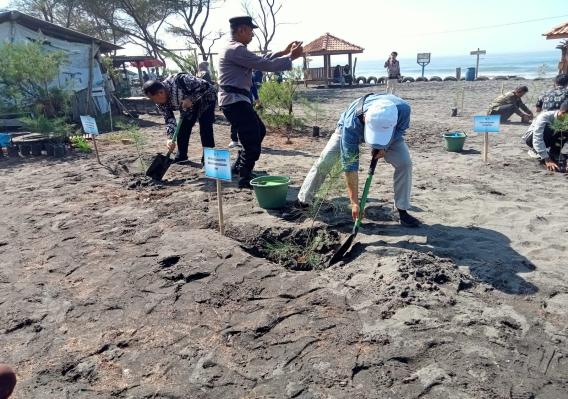UNY partners with the Gajah Sumatra Foundation to plant trees at Bidara Beach

The Universitas Negeri Yogyakarta carried out a series of activities in Kalurahan Bugel, Kapanewon Panjatan, Kulon Progo — namely the planting of trees at Pantai Bidara on Saturday.
The tree-planting was done by the Regional Secretary’s Expert Staff of the Kulon Progo Regency, Drs. Eko Pranyoto, UNY’s Vice-Rectors and several local officials.
In his speech, the Expert Staff thanked the selection of Kalurahan Bugel, Kapanewon Panjatan as the site for the activity. “The hope is that this will not merely end with a symbolic tree-planting today. I will also endeavour to carry out simultaneous planting by involving other UPD (units) and relevant offices,” said Eko Pranyoto. This is part of disaster preparedness such as coastal abrasion and similar issues.
He noted that the Terbah area is becoming like a new town because the economic life is quite active due to the presence of the UNY Wates campus, making Kulon Progo more well-known.
The Vice-Rector for Research, Cooperation, Information Systems and Business at UNY, Prof. Margana, said that the tree-planting is one of the aspects of habluminallah, hablumminannas and hablumminalam (“relations with God, relations with people and relations with nature”). “This is one of UNY’s focus areas in caring for the environment, where 2,000 trees will be planted,” he said.
This activity is a collaboration between UNY’s Centre for Disaster & Climate Change Mitigation (in the Directorate of Cooperation, Information Systems & Business) and Yayasan Gajah Sumatera (Yagasu), assisted by the student organisation team from BEM KM UNY. Yagasu is an NGO founded 17 July 2001, originally focusing on elephant conservation; since 2006 it shifted its structure and name and now works on mangrove ecosystem restoration, supporting biodiversity, communities and climate, developing programmes and doing scientific research to protect environment and community.
According to Dr. Tien Aminatun, Head of the Centre for Disaster & Climate Change Mitigation, coastal vegetation plays a role not only in protecting the coast from abrasion but also in absorbing and storing carbon and converting it into oxygen through photosynthesis. Thus, coastal vegetation contributes to reducing carbon dioxide concentrations (a greenhouse gas that contributes to global warming and triggers climate change).
Tree vegetation also helps reduce air pollution, provide shade, create a greener environment and improve air –and life-quality.
The lecturer from the Faculty of Mathematics & Natural Sciences explained the importance of such coastal vegetation and based on request from Kalurahan Bugel (Kapanewon Panjatan, Kulon Progo Regency), UNY’s Centre for Disaster & Climate Change Mitigation together with Yagasu organised the tree-planting to prevent coastal abrasion at Pantai Bidara.
In the activity, approximately 2,000 seedlings of cemara laut (Casuarina/sea-pine) trees, provided by Yagasu, will be planted along the coastline for a stretch of about 2 kilometres.
The tree planting does not stop at planting and leaving it; but will be followed by maintenance of the trees to ensure they grow well and function properly in their role as shoreline erosion buffers and carbon sinks to help address global climate change. “This maintenance will be carried out by the Pantai Bidara Tourism Awareness Group (Pokdarwis) which will be assisted by Yagasu and UNY’s Centre for Disaster & Climate Change Mitigation over 20 years,” she said.
The planting of 20 cemara laut seedlings symbolised the start of the coastal greening programme to prevent abrasion and absorb carbon to help address global climate change.






